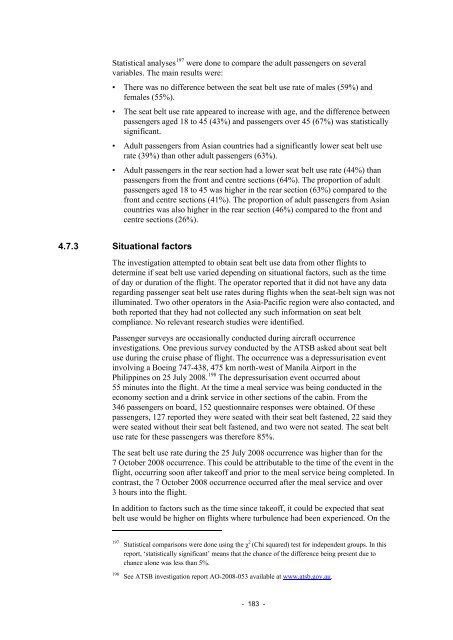In-flight upset - 154 km west of Learmonth, WA, 7 October 2008,
In-flight upset - 154 km west of Learmonth, WA, 7 October 2008,
In-flight upset - 154 km west of Learmonth, WA, 7 October 2008,
- No tags were found...
Create successful ePaper yourself
Turn your PDF publications into a flip-book with our unique Google optimized e-Paper software.
Statistical analyses 197 were done to compare the adult passengers on severalvariables. The main results were:• There was no difference between the seat belt use rate <strong>of</strong> males (59%) andfemales (55%).• The seat belt use rate appeared to increase with age, and the difference betweenpassengers aged 18 to 45 (43%) and passengers over 45 (67%) was statisticallysignificant.• Adult passengers from Asian countries had a significantly lower seat belt userate (39%) than other adult passengers (63%).• Adult passengers in the rear section had a lower seat belt use rate (44%) thanpassengers from the front and centre sections (64%). The proportion <strong>of</strong> adultpassengers aged 18 to 45 was higher in the rear section (63%) compared to thefront and centre sections (41%). The proportion <strong>of</strong> adult passengers from Asiancountries was also higher in the rear section (46%) compared to the front andcentre sections (26%).4.7.3 Situational factorsThe investigation attempted to obtain seat belt use data from other <strong>flight</strong>s todetermine if seat belt use varied depending on situational factors, such as the time<strong>of</strong> day or duration <strong>of</strong> the <strong>flight</strong>. The operator reported that it did not have any dataregarding passenger seat belt use rates during <strong>flight</strong>s when the seat-belt sign was notilluminated. Two other operators in the Asia-Pacific region were also contacted, andboth reported that they had not collected any such information on seat beltcompliance. No relevant research studies were identified.Passenger surveys are occasionally conducted during aircraft occurrenceinvestigations. One previous survey conducted by the ATSB asked about seat beltuse during the cruise phase <strong>of</strong> <strong>flight</strong>. The occurrence was a depressurisation eventinvolving a Boeing 747-438, 475 <strong>km</strong> north-<strong>west</strong> <strong>of</strong> Manila Airport in thePhilippines on 25 July <strong>2008</strong>. 198 The depressurisation event occurred about55 minutes into the <strong>flight</strong>. At the time a meal service was being conducted in theeconomy section and a drink service in other sections <strong>of</strong> the cabin. From the346 passengers on board, 152 questionnaire responses were obtained. Of thesepassengers, 127 reported they were seated with their seat belt fastened, 22 said theywere seated without their seat belt fastened, and two were not seated. The seat beltuse rate for these passengers was therefore 85%.The seat belt use rate during the 25 July <strong>2008</strong> occurrence was higher than for the7 <strong>October</strong> <strong>2008</strong> occurrence. This could be attributable to the time <strong>of</strong> the event in the<strong>flight</strong>, occurring soon after take<strong>of</strong>f and prior to the meal service being completed. <strong>In</strong>contrast, the 7 <strong>October</strong> <strong>2008</strong> occurrence occurred after the meal service and over3 hours into the <strong>flight</strong>.<strong>In</strong> addition to factors such as the time since take<strong>of</strong>f, it could be expected that seatbelt use would be higher on <strong>flight</strong>s where turbulence had been experienced. On the197Statistical comparisons were done using the χ 2 (Chi squared) test for independent groups. <strong>In</strong> thisreport, ‘statistically significant’ means that the chance <strong>of</strong> the difference being present due tochance alone was less than 5%.198See ATSB investigation report AO-<strong>2008</strong>-053 available at www.atsb.gov.au.- 183 -



